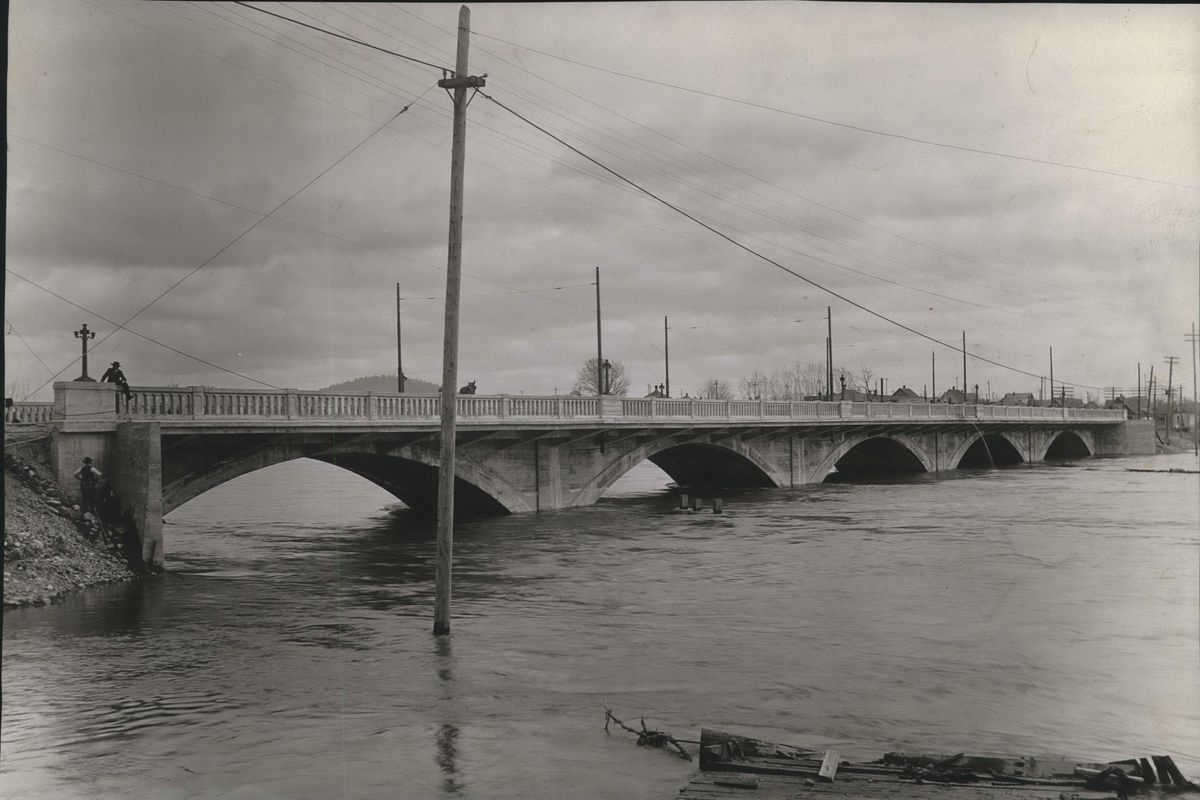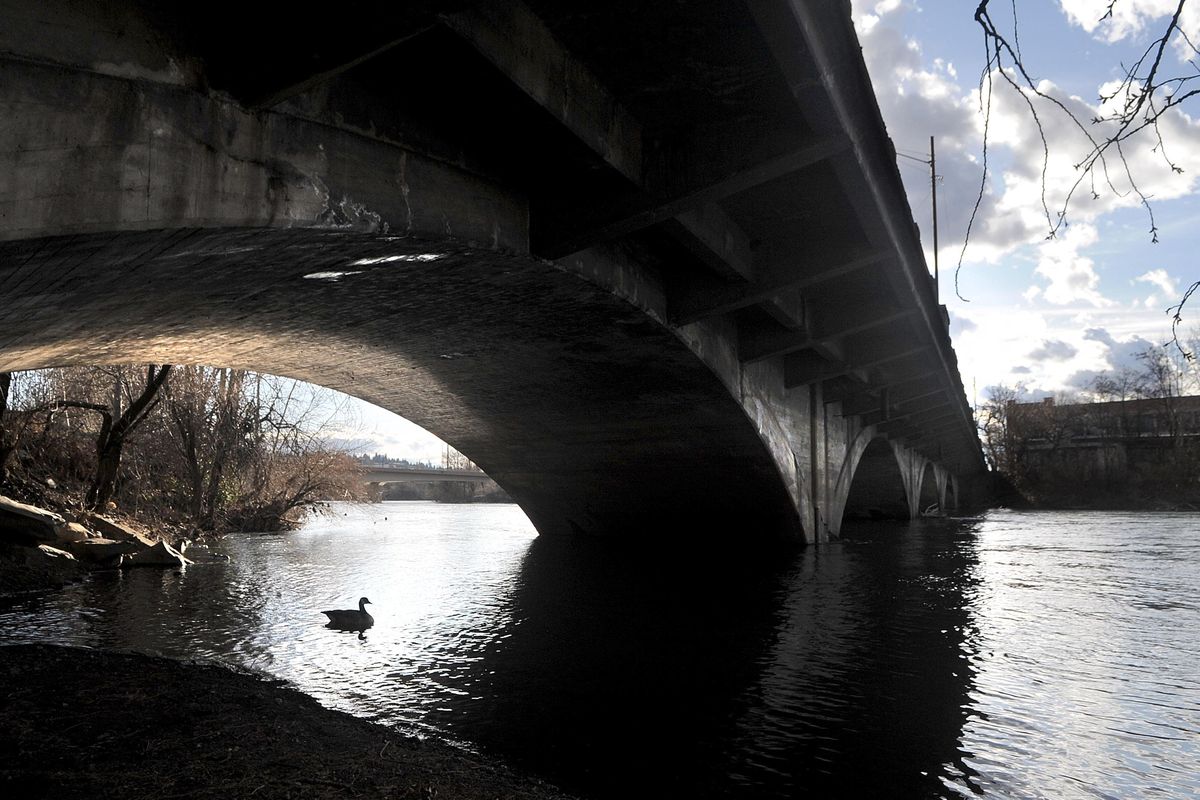Getting There: Historic bridge on Trent soon to be removed
The Olive Avenue Bridge, later known as the East Trent Bridge, is seen in this historic photo from the Spokesman-Review archives. (Spokesman-Review archives)
After 108 years, the historic East Olive Avenue Bridge is a goner.
Never heard of it?
Built in 1910, it’s an early example of a bridge with steel-enforced concrete arches. It was constructed by the city and the Inland Empire Railway, which ran streetcars over the bridge for nearly 30 years. It was raised over the Spokane River when the city was hurriedly replacing its wooden and steel truss bridges, giving the town a modern appearance and the unofficial moniker City of Bridges.
The Monroe Street Bridge is probably the best example of a concrete bridge’s beauty, but the East Olive Avenue Bridge is no slouch.
Still haven’t heard of it? Fine, let’s call it by its modern name: the East Trent Bridge.
Even if you’ve never appreciated its charm, you’ve probably driven over it. It sees an average of 11,000 vehicle crossings a day – and it shows it. That’s why the Washington State Department of Transportation, which took over the bridge in 1937 when Trent became a secondary state highway, is about to replace it.
The modern $20 million span taking its place is funded by the Federal National Highway Performance Program, Federal Surface Transportation Program, State of Washington Motor Vehicle Account and State of Washington Transportation Partnership Act of 2005.
“Underneath the pavement are train track ties because it used to have a trolley,” said Al Gilson, spokesman with WSDOT, of the older bridge. “It’s bumpy, and it’s bumpy. We just can’t put any more asphalt on it. We can’t keep patching the roadway. So it’s a full replacement.”
And that’s what has Megan Duvall, the historic preservation officer with the city and county, a bit down.
The bridge meets the criteria to be placed on the National Register of Historic Places due to its contribution to Spokane’s rapid development in the early 20th century. Since the state owns the bridge and is building its replacement with some federal funding, they’re obligated to look at the project’s impact on historic resources.
“Demolishing it is obviously an adverse effect, in preservation language,” Duvall said.
That said, she isn’t agitating for the project to stop, or to have the replacement look exactly like its historic forebear.
Instead, she and a few other interested parties are trying to think of ways to “offset the loss of the bridge” in some way.
“I had some great big ideas that have all been shot down for one reason or the other,” Duvall said. “I thought it’d be cool to have projectors built into the new bridge that would project images of the old bridge into the water. Kind of like a shadow of the old bridge.”
Turns out, you can’t shine lights on the river for ecological reasons.
Other ideas floating around include having the state transportation department buy some riverfront land near the bridge and create a new spot for the public to access the river, or have it fund improvements of the Centennial Trail near the bridge, or create a local historic district along East Sprague Avenue.
“That’s a lasting thing that has a direct impact on Spokane,” Duvall said of the Sprague idea.
Still, the group of consulting parties – which includes retired bridge engineers and representatives from the Historic Bridge Foundation, the state Department of of Archeology and Historic Preservation, the Washington Trust for Historic Preservation and HistoricBridges.org – aren’t quite on the same page yet, and the deadline looms. The bridge is currently being designed by engineers in Olympia and construction is expected to start in 2019.
“We’ve thrown a lot of ideas around,” Duvall said. “It’s going to be interesting. We really can’t make up for the loss of a historic property, but there are some things we can get back.”
Bridge work on U.S. 195 will cause delays
If you’re heading south on U.S. Highway 195, be prepared for up to 20 minutes added to your drive time.
Beginning today, temporary traffic signals will be up at three locations in the vicinity of Steptoe and Rosalia to assist crews in bridge deck repairs and grinding.
The work, at mile posts 48, 63 and 65, is significant, and the Washington State Department of Transportation is suggesting that drivers with time-sensitive travel should consider alternate routes.
Preparations for North Monroe work
Work to renovate North Monroe will begin April 2, but in preparation for the work, crews will be re-striping the detour route, Post Street, which could start Wednesday depending on weather.
The Monroe project is approximately 16 blocks long and will be completed in four segments. The segments not under construction, each four blocks long, will be open to local traffic, and there will be a total of eight blocks under construction at any one time.
This project includes: new pavement, lane reconfiguration from five to three lanes, wider sidewalks, bump-outs, installation of High Performance Transit elements, upgraded street lighting, new pedestrian lighting and stormwater management.
The $7.1 million project will reduce Monroe’s lanes from five to three between Northwest Boulevard to the North Hill, construct more visible crosswalks and make the business center’s sidewalks wider with more trees and benches.
For more information, visit monroeproject.com.
Interstate 90
On Tuesday and Wednesday, minor pavement grinding on Interstate 90 in Lincoln County might create lane restrictions. The work between the Adams and Spokane county lines requires dry weather.
In Coeur d’Alene, drivers should look out for work between Westbound Huetter Rest Area and Exit 17: Mullan Road. The work, which began last week, is expected to go into October. Speeds will be lowered to 55 mph during night work, which takes place from 7 p.m. to 5 a.m.
Better curb ramps coming to South Hill
The Americans with Disabilities Act curb ramp project in Spokane City Council District 2 will start today.
Crews will be working in the following areas: Fifth Avenue and Bernard Street, Sixth Avenue and Browne Street, Sixth Avenue and Bernard Street, Eighth Avenue and Browne Street, Eighth Avenue and Laura Street, and Ivory Street and Nina Avenue.

